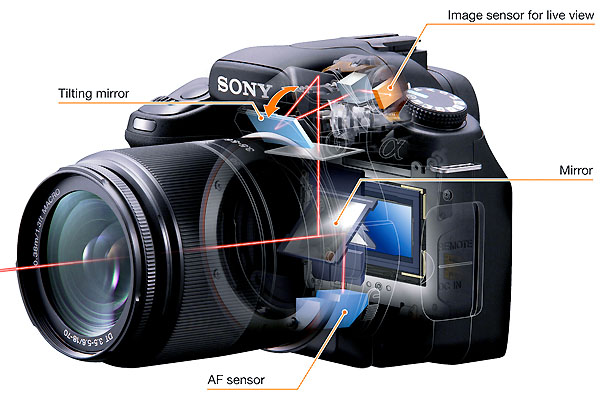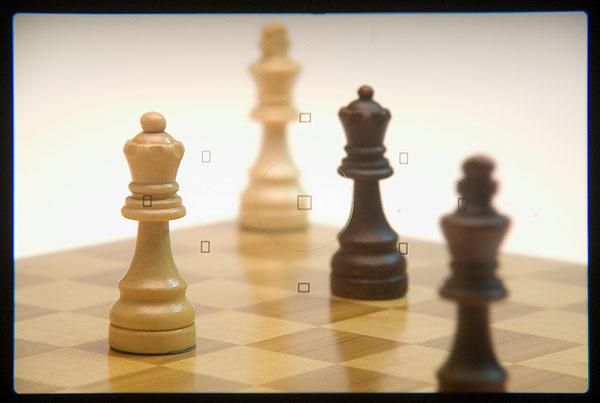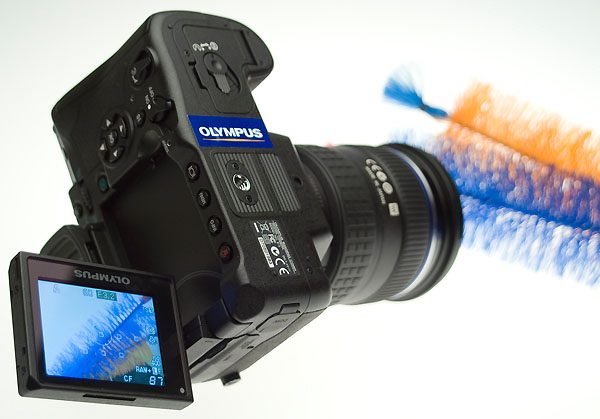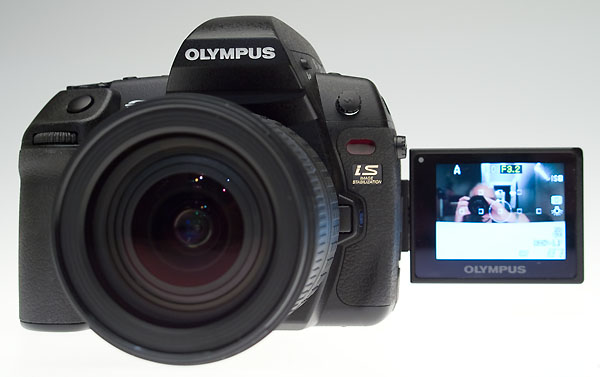How the live view A300 and A350 will work
NOT everyone will want the live view offered by the A300 and A350 – it does turn out to be more or less as we suggested, a secondary optical path adjacent to the eyepiece inside the prism housing. I’ll explain here exactly what the implications are, and why a future model – let’s call it the A500 – offering the 14.2 megapixel sensor without the live view may be worth waiting for.

The Sony PR diagram does not tell the full story. The CCD is equipped with a lens of its own, as well as the 45 degree prism for reflecting the light to keep the optical path long enough. The part of the porroprism which moves, at the front, is exactly the same as a normal prism face when in its optical viewing position.
Although this is a moving part and subject to alignment and collimation during assembly, any error in position will have no effect at all on image quality. All it will affect will be fine adjustment of the viewfinder dioptre control. If it does become misaligned due to shock or wear, the live view image might be slightly defocused or wrongly centered, but again, this would have no impact on autofocus or image quality. The system is just like having a built-in Zigview with a rather better screen.
Placing the CCD at a right angle like this, rather than in a large eyepiece surround, has forced a reduction in viewfinder magnification to 0.74X in place of the 0.83X of the Alpha 200. I think that a direct path using an extended eyepiece, taking your eye further from the camera back as in the Nikon D3, could have been possible. With a larger ocular, a more distant eyepoint could be been maintained without loss of magnification, which depends mainly on the eyepiece design not the prism itself.
External dimensions are important to Sony. They have already stated they want to capture the digicam upgrading market, younger users and female users. All come from a background experience where the live view composition on a screen is the only thing they know. They expect to find a DSLR able to do the same. They also want a small camera, without too much evidence of functional parts interfering with overall portability and neat style. By making the path to the live view CCD folded, Sony has retained a normal looking external style.
Misleading viewfinder ‘magnifications’
After all, what is 0.74X? Canon’s EOS 450D is 0.87X but has a 1.6X sensor in place of 1.5X, which means it’s the same as 0.81X in Sony terms (actually, a smaller finder than the Alpha 200, though the specifications would imply it is larger – not many reviewers bother to consider that the Canon uses a smaller image area). All these cameras show a nominal 95% of the image area, and the magnification is expressed in terms of a 50mm lens. This is how it was always done with 35mm full frame models. But relative to full frame, the finders are already smaller. The Alpha 200 has a view which is really 0.55X if compared to the figures quoted for full frame; the Canon 450D has a view which is 0.54X; the Alpha 300/350 has a view which is 0.49X. The Canon EOS 400D, a more strictly comparable camera, has a quoted 0.8X finder which is nearly identical to the Alpha 300/350 – a 0.75X equivalent after allowing for the smaller format.
We should, anyway, be talking about viewfinder minifications these days!
So the new cameras are about the same as a 400D, which people find perfectly usable even if there are complaints of ‘tunnel viewfinder’ occasionally heard. There will be about the new Sony models.
Viewing the screen
What the live view of the A300/350 does is to show a video image of the focusing screen. This means it shows what the eye would show through the viewfinder. On our sister site, dPhotoexpert.com, you can read a complete article which explains why ‘real’ live view is very useful for judging the true appearance of pictures taken with wide aperture lenses. I’ll use a couple of Canon 40D images from this article here, to show you what this means.

This is a shot taken, through the eyepice of a Canon EOS 450D, of a shot composed with the 85mm f/1.2 lens wide open. This is accurate (I have checked the optical aspects of doing this) and actually shows what your eye will see. The picture was taken with a Dynax 7D using a Loreo 35mm PC lens in a cap focused by adjusting the viewfinder dioptre.

This is the actual depth of field taken at f/1.2 – why is it so different? The answer is that modern viewfinder screens are semi-transparent, because so much light is lost with the secondary AF mirror system they would be extremely dim with a normal groundglass. A semi-transparent screen will act to create a ‘pupil’ in the lightpath, meaning that no matter how wide a lens aperture you use, the view will never show depth of field accurately at any f-stop wider (smaller numerically) than around f/4.5.
The Alpha 300/350 have no depth of field preview button. As you will realise from the above, depth of field preview on a modern DSLR is next to useless anyway – it does give you some idea at very small apertures, but does not allow accurate viewing of differental focus with lenses around Æ’/2, Æ’2.8, Æ’1.4 and so on. No indication has yet been given whether the D350 will have a software-controlled depth of field mode. It definitely offers exposure compensation and white balance adjustment preview:
“The effects of exposure compensation and white balance can be conveniently previewed in live view mode” – UK press release.
However, there is no mention of whether it will also show applied effects like contrast and saturation adjustments. It will preview the BW and Sunset modes – but these are the only creative controls mentioned.
The Live View direct on the sensor, as used by the Canon EOS 450D, gives a precise preview of depth of field because you can also use a mode with auto gain to preview stopped-down apertures. It will also give a preview of all the image setting adjustments.
The system introduced by Sony is not new – it is essentally the same as Live View Mode A from the Olympus E-330 which also uses a video CCD viewing a image diverted from the optical eyepiece.
The key advantages of the Sony method over sensor-fed LV are:
- Real-time, live, action tracking autofocus remains active when using Live View.
- The LV sensor takes over metering using a 1200-point dynamic measurement providing fuller pre-processing information to the Apical IRIDIX processor for DRO adjustment (thanks to Mladen at www.dyxum.com for this information).
- TTL-ADI flashmetering through the prism meter system is unaffected (subject to confirmation).
- A CCD sensor can be used, with noise benefits. Contrary to some beliefs CCDs are inherently lower noise than CMOS, and live view makes CMOS sensors noisier by heating them up (if used for a long period).
- Frames per second rate, sequence shooting, self-timer, mirror up timer and other aspects of the normal camera functions are all retained.
- Switching to live view is instant and trouble free, at any time, and only one simple LV mode is needed. Real live view DSLRs are a pain in the fundament and very often the live view can not be used hand-held.
The key disadvantages of the Sony method are:
- Live View does not show 100% of the image, which is the case with off-sensor systems; it shows only 90%, and the specifications do not make it clear whether it views 90% of the screen (which already only shows 95%) or 90% of the total image area captured. Either way, it’s a heavily cropped live view.
- Off-sensor contrast detection focusing can not be used, and the camera is prone to front or back focus issues as normal; these can not be detected in the live view.
- The live view image shows all the markings of the focusing screen, necessary or otherwise. In the Sony implementation these are used postively by adding electronic markers for the nine-point AF system.
- Exposure, depth of field, brightness and colour balance are not reflected in the live view image, and may all look different in the actual image.
- The additional sensor system and fulltime use of the rear screen reduces battery life by around 35 per cent.
- Live View does not show image stabilisation effect, unlike the LV of cameras like the Konica Minolta Dimage A1/A2/A200 where it can be shown optionally.
- Although there is a ‘Digital TeleConverter ‘ 1.4X or 2X zoom in button for the Live View, this does not enable any more accurate manual focusing than using a focus magnifier on the optical screen. What it does is to activate digital zoom on the actual picture. It is not clear whether this is a crop or an interpolation to the chosen output size.
- The additional space used has forced the pop-up flash to be on shorter hinged arms, making its position much closer to the lens axis, and therefore more prone to red-eye. Since the Alpha 200 shares this design without needing to, it is also slightly hampered compared to older models with a higher flash position.
Finally, Sony has decided to keep the rear screen as robust as possible. Unlike the S0ny DSC R-1 or the Olympus E-3 which allow the focusing screen to be swivelled to almost any angle and orientation, the Sony only operates in the horizontal plane allowing waist level, ground level, slightly angled, and slightly overhead camera positions in landscape format (130° swivel upwards, 40° down-facing). The screen does not extend to a position for self-portraits, or turn to make vertical compositions at waist level or overhead possible. In this respect it resembles the Konica Minolta A1/A2 most of all, but you can’t do this:

and it can’t do this:

So there is room in future for Sony to improve the live screen by giving it a wider range of articulation and swivel for difficult camera positions and self-portrait/self-timer mode viewing.
Conclusion
Overall, my personal opinion is that the A300/350 are not ideal for our own use, while the A200 is an acceptable replacement for the A100. I would have liked to have seen an ‘A250’ with the 14 megapixel sensor in a non-live view body with the slightly better viewfinder, or preferably an A750 with that sensor in a 700 body. This is not to say that the A300/350 miss the mark. In fact, the live view of the Canon 450D, Olympus E-3 or Nikon D300 is beyond the command of the average camera buyer. It is almost useless for the purposes of the public.
Sony’s live view, in contrast, is exactly what is needed in a camera to be tried out in a store by someone graduating from a consumer digicam or a cameraphone. It will press all the right buttons without requiring too many button presses or leaving the user in a hopeless loop of uncertainty about whether or not a picture has been taken or the mode cancelled.
Please feel free to register with Photoclubalpha and add your comments, or visit our Forum to talk about this with other Alpha system users.
– David Kilpatrick

As an E-330 User I have found the Live view mode A which is similar to A-350 to be very useful, my camera is set on this mode as default. The lack of DOF preview etc is a problems sometimes but mostly not at all so the A350 system will work fine for most of the time. The E-330 has another live view Mode B which is like the Canon system. The mirror locks up and the viewfinder is blacked out. The screen image is 100% of the main sensor. The big attraction of this system is the selectable area which can be blown up 10X for focusing macro. Hav ing thought about it I use the Mode A (A-350 type) most of the time. Both are no substitute for a good TTL viewfinder.
The Live View is bound to black out during the picture, because the mirror will lift, and it must disppear like any prism view. I have not used or handled a camera as no samples are available yet in the UK. First, there may be a delay in restoring the video feed; secondly, it is possible the processor shares somes functions but this seems unlikely; thirdly, you must be able to review the captured image and this of course would interrupt Live View too unless disabled. I would not imagine that Live View can be used for continuous sequences, but the same applies to other types of Live View as well – they simply are not intended for action sequence shooting even if you can make some use of them.
David
I have read in the latest issue of Chasseur d’Images that the liveview screens blacks out for one second after taking a picture. Would this mean that in continuous shooting, liveview is continuously black? This would be a deal breaker for me.
Their explanation is that the processor must complete the processing of the image before restoring the liveview functionality.
None of the previews of the A350 that I have read mention this problem. I wonder if Chasseur d’images did not have a very early pre-release sample.
Did you have a chance to test the A350? Did you notice anything like that?
David, what sensor use both camera for LV? and the CCD 14MPx is a new sensor??
Grat article…
It’s pretty cool anyway, DK. I have made a boatload of great macro and semi macro, and even street images with the Minolta 7hi and it’s tilting viewfinder. This seems to be a great way to use some good glass and take advantage of the cropability and easy post production tweaks offered by the large raw files.
I may try one of these cheap lv cameras, the prospect of good glass and the moveable screen will allow me to get some stuff easily, stuff that normally would take some extra work with the A700 or other non-live-view cameras.
Quick work on this one, DK.
-Sonolta
http://www.sonolta.com